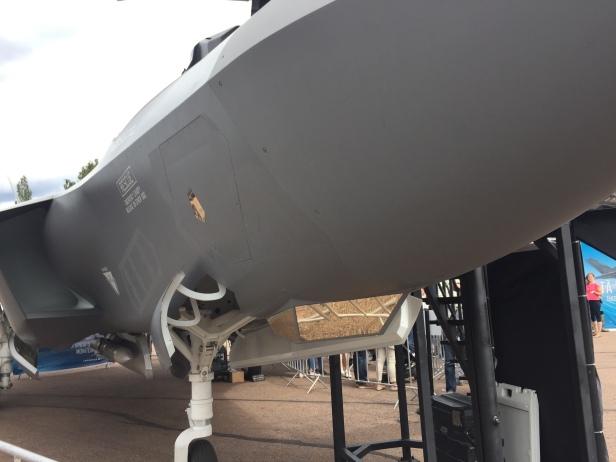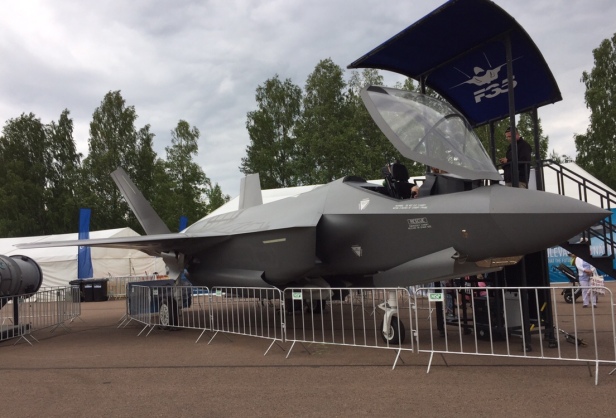F-35 is in many ways the fighter to beat in the HX-program, having been chosen by both Norway and Denmark, and sports a perfect record in all fighter programs where it has competed (though in a number of cases not without controversy). This fits Lockheed-Martin perfectly, as the company representatives are confident in their fighter.
The way you operate the F/A-18 today, you can operate the F-35 tomorrow
That’s the response from Mark Pranke, the Finland F-35 Campaign Manager, when I raise the ever present question if the stealth fighter really can operate from road bases in subarctic conditions. He goes on to describe how the stealth coatings earlier known for being extremely maintenance intensive have taken quantum leaps when it comes to robustness. The aircraft is designed for a lifespan of 8,000 hrs in all versions (in other words, the harsh naval requirements likely sets the standard for operating environment), and Lockheed-Martin are already confident that it can handle two, likely even three times that.

However, stealth is not the only unique selling point of the F-35 if you ask Billie Flynn, Lockheed-Martin’s longtime test pilot (who also happens to have considerable CF-18 Hornet experience from the Canadian Air Force, including as commander of the Canadian Hornets in Operation Allied Force). In his words, sensor fusion increases the pilots situational awareness with “orders of magnitude”, and is the second defining feature of the fifth generation. Notably, major general (eng.) Renko of the Finnish Defence Logistics Command downplayed the importance of stealth when faced with the question at the presser following the release of the RFQ, and instead labelled significant improvements in sensors and sensor fusion as the defining feature of modern fighters, and went on to note that all HX-candidates have them. Flynn doesn’t quite agree.
We do sensor fusion, the others have sensor correlation
The way F-35 presents information from a multitude of sensors covering an area stretching hundreds of kilometers in all directions is nothing less than a “paradigm shift” according to Flynn. “AWACS would gather data we get everyday with the F-35”, he explains. He gets backed up by Yung Lee, Director International Business Development Northern Europe, who notes that “more sensors means more data”. Looking forward, the company expects that intelligence, surveillance, and reconnaissance (ISR) will be an important role for the aircraft in the future, thanks to its advanced sensor suite.

And if Renko isn’t necessarily impressed by stealth (at least not openly), Flynn maintains its importance on the modern battlefield. “It’s not Harry Potter’s cloak of invisibility” (a clear comeback in Saab’s direction), but it makes the aircraft difficult enough to see that it allows the F-35 to operate with impunity, and the best measure of its importance is the results at Red Flag.
Best we ever did [with earlier fighters] was 2:1, now we are 20:1 [in air-to-air kills]
Looking forward, the plan is for the fighter to go through so called tech refresh cycles every fourth year, where both hardware and software are renewed to keep the F-35 up to date. The funding for the research and development is largely covered by the US, with Finland only having to fund the new hardware (mainly increases in processing power). This way of working harnesses the power of economics of scale to produce a common baseline for the aircraft, with local changes mainly coming down to different weapons, threat libraries, and mission data files. While the approach saves money, it also leaves Finland with relatively limited possibilities to influence the developments of the program as a whole. But as said, Lockheed-Martin is confident that they have the right model for Finland. And the slot is available. “Deliveries to the partner nations will largely have finished by 2021,” Pranke notes. “We will have no problem fitting in a Finnish order.”


“major general (eng.) Renko of the Finnish Defence Logistics Command downplayed the importance of stealth when faced with the question at the presser following the release of the RFQ, and instead labelled significant improvements in sensors and sensor fusion as the defining feature of modern fighters”
Quite worrying statement if true. I was hoping that the people who are making the decisions would be well informed on technology. For example people tend to ignore (or just don’t know) the fact that the stealth aircraft benefit more from electronic warfare than conventional aircraft do.
Renko has advanced through the ranks of the Air Force and now the joint Logistics Command as a specialist engineering officer. If there’s anyone in Finland able to make informed decisions on the impact of technology when it comes to aerial warfare in Finland for the next few decades, it is him. I have full confidence in his judgement when it comes to HX (though granted I don’t expect him to tell the general public everything he knows).
Having a several orders of magnitude lower radar cross section is an overwhelming advantage which should be obvious to anyone with a decent grasp of physics and math. Which is why all important countries (USA, Russia, China and even the Europeans are slowly getting on board) are investing billions in stealth technology.
I think it’s highly unlikely that Renko has figured out something that all the PhD’s working for companies that are spending billions in R&D have missed.
If Renko was to make a statement on how stealth is an overwhelming advantage, it could be construed as undue favoritism towards the JSF. I wouldn’t take it too seriously.
“We do sensor fusion, the others have sensor correlation”
Flynn and LM busting lies again. Before the JSF, only two fighters had true sensor fusion, the Raptor indeed, and the Rafale, part of HX.
Super Hornet bl. III is getting major software updates allowing sensor fusion as well (and not only correlation).